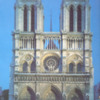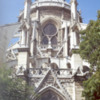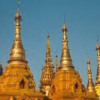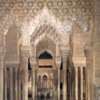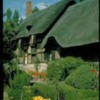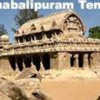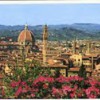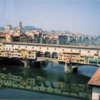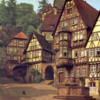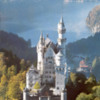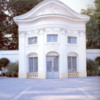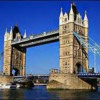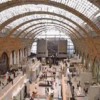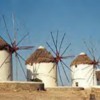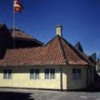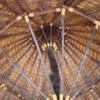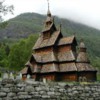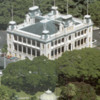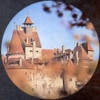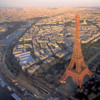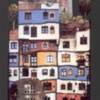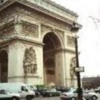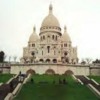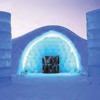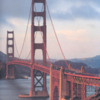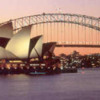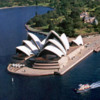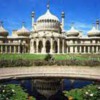Thank you Teo for your wonderful architectural sketches. The best example of Gothic architecture is one of the oldest French gothic cathedrals in Paris, France:
Notre Dame Cathedral (c.1163-1235)
Yangon Myanmar
Shwedagon Paya,
It is today, still the most sacred of Buddhist sites in Myanmar. The present structure, after much enlarging and rebuilding over the centuries, consists of a massive stupa that rises 100 meters and topped by a diamond-encrusted orb, surrounded by several smaller zedis, shrines and pavilions. Almost every corner of the complex is decorated with intricate carvings painted in gold and exuberant reds, blues, and yellows.
Shwedagon Paya,
It is today, still the most sacred of Buddhist sites in Myanmar. The present structure, after much enlarging and rebuilding over the centuries, consists of a massive stupa that rises 100 meters and topped by a diamond-encrusted orb, surrounded by several smaller zedis, shrines and pavilions. Almost every corner of the complex is decorated with intricate carvings painted in gold and exuberant reds, blues, and yellows.
Attachments
The Alhambra
Granada, Spain
Spain was conquered in 714 A.D. by Muslim armies (after being conquered by, among others, Romans and Visigoths). During the 800 years until Spain was reconquered by Christians, the Muslims greatly influenced the culture of Spain. During the middle ages, when little mathematics and science were being done in the rest of Europe, Spain was an intellectual center.
The Alhambra is a walled city and fortress in Granada, Spain. It was built during the last Islamic sultanate on the Iberian peninsula, the Nasrid Dynasty (1238-1492). The palace is lavishly decorated with stone and wood carvings and tile patterns on most of the ceilings, walls, and floors. Islamic art does not use representations of living beings, but heavily uses geometric patterns, especially symmetric (repeating) patterns.
Granada, Spain
Spain was conquered in 714 A.D. by Muslim armies (after being conquered by, among others, Romans and Visigoths). During the 800 years until Spain was reconquered by Christians, the Muslims greatly influenced the culture of Spain. During the middle ages, when little mathematics and science were being done in the rest of Europe, Spain was an intellectual center.
The Alhambra is a walled city and fortress in Granada, Spain. It was built during the last Islamic sultanate on the Iberian peninsula, the Nasrid Dynasty (1238-1492). The palace is lavishly decorated with stone and wood carvings and tile patterns on most of the ceilings, walls, and floors. Islamic art does not use representations of living beings, but heavily uses geometric patterns, especially symmetric (repeating) patterns.
Attachments
Anne Hathaway's Cottage was the home of Shakespeare's wife before they married in 1582. Besides its romantic associations, as the place where the teenage Shakespeare courted his future wife, the Hathaway home has also come to be regarded as the quintessential English country cottage. The thatched farmhouse continued to be inhabited by the Hathaway family and its descendants until the late 19th century.
Attachments
TajMahal, India
Taj Mahal stands on the bank of River Yamuna, which otherwise serves as a wide moat defending the Great Red Fort of Agra, the center of the Mughal emperors until they moved their capital to Delhi in 1637. It was built by the fifth Mughal emperor, Shah Jahan in 1631 in memory of his second wife, Mumtaz Mahal, a Muslim Persian princess. She died while accompanying her husband in Burhanpur in a campaign to crush a rebellion after giving birth to their 14th child. The death so crushed the emperor that all his hair and beard were said to have grown snow white in a few months.
Taj Mahal stands on the bank of River Yamuna, which otherwise serves as a wide moat defending the Great Red Fort of Agra, the center of the Mughal emperors until they moved their capital to Delhi in 1637. It was built by the fifth Mughal emperor, Shah Jahan in 1631 in memory of his second wife, Mumtaz Mahal, a Muslim Persian princess. She died while accompanying her husband in Burhanpur in a campaign to crush a rebellion after giving birth to their 14th child. The death so crushed the emperor that all his hair and beard were said to have grown snow white in a few months.
Attachments
India
The Pallava dynasty ruled from AD 600 to 900. The characteristic feature of the Pallava temple architecture is the rock-cut temples. The finest specimen of rock-cut shrines can be seen at Mahabalipuram. The Shore temple at Mahabalipuram is a fully carved temple complex with a towered sanctuary and mandapa.
The Pallava dynasty ruled from AD 600 to 900. The characteristic feature of the Pallava temple architecture is the rock-cut temples. The finest specimen of rock-cut shrines can be seen at Mahabalipuram. The Shore temple at Mahabalipuram is a fully carved temple complex with a towered sanctuary and mandapa.
Attachments
Gates of Paradise Doors,
Firenze, Italy
Among the many treasures of Grace Cathedral, the ones most visible to visitors are the great east doors, replicas of the famed Doors of Paradise. Their shimmering gold surfaces beckon the pilgrim up the great stairway to look in awe at the intricately sculpted and nearly three-dimensional panels. The original doors, by master sculptor and craftsman Lorenzo Ghiberti, stood at the east entry of the ancient Baptistry of the Duomo (Cathedral) in Florence, Italy. Now in the Duomo museum (replaced by a replica), they are considered by many art historians to mark the beginning of the Renaissance. Their popular name- Doors of Paradise- is based on a tradition that the young Michelangelo, greatly impressed by the doors, described them as worthy to be the Gates of Paradise.
Firenze, Italy
Among the many treasures of Grace Cathedral, the ones most visible to visitors are the great east doors, replicas of the famed Doors of Paradise. Their shimmering gold surfaces beckon the pilgrim up the great stairway to look in awe at the intricately sculpted and nearly three-dimensional panels. The original doors, by master sculptor and craftsman Lorenzo Ghiberti, stood at the east entry of the ancient Baptistry of the Duomo (Cathedral) in Florence, Italy. Now in the Duomo museum (replaced by a replica), they are considered by many art historians to mark the beginning of the Renaissance. Their popular name- Doors of Paradise- is based on a tradition that the young Michelangelo, greatly impressed by the doors, described them as worthy to be the Gates of Paradise.
Attachments
The ruins of Hadrian's Wall form the most spectacular Roman remains in Britain. The mighty wall ran across the whole width of Britain, from Wallsend (Newcastle-upon-Tyne) in the east to Bowness-on-Solway in the west.. The wall was originally 15feet high with 6 foot battlements on top of that. It was begun in about 120 A.D. on the orders of the Emperor Hadrian, and was manned until it was abandoned in 383
Attachments
Neuschwanstein Castle, Germany
This is King Ludwig's magnificent and most famous castle, built in the neo-late romanesque style. With its turrets and mock-medievalism, its interior styles ranging from Byzantine through Romanesque to Gothic its a real fairy-tale fantasy come true. It was built between 1869 and 1886 for the Bavarian King Ludwig II. A splendid and imaginative "fairy-tale castle" high above the Alpsee lake with the Alps towering above it.
Only about a third of the building was actually completed.
This is King Ludwig's magnificent and most famous castle, built in the neo-late romanesque style. With its turrets and mock-medievalism, its interior styles ranging from Byzantine through Romanesque to Gothic its a real fairy-tale fantasy come true. It was built between 1869 and 1886 for the Bavarian King Ludwig II. A splendid and imaginative "fairy-tale castle" high above the Alpsee lake with the Alps towering above it.
Only about a third of the building was actually completed.
Attachments
Louvre Museum, Paris France
The Palace
A medieval fortress, the palace of the kings of France, and a museum for the last two centuries, the architecture of the Louvre Palace bears witness to more than 800 years of history.
Two Centuries as a Museum
Established in 1793 by the French Republic, the Louvre Museum, in the company of the Ashmolean Museum (1683), the Dresden Museum (1744) and the Vatican Museum (1784) is one of the earliest European museums.
The pyramid was added in front of the palace in 1985.
The Palace
A medieval fortress, the palace of the kings of France, and a museum for the last two centuries, the architecture of the Louvre Palace bears witness to more than 800 years of history.
Two Centuries as a Museum
Established in 1793 by the French Republic, the Louvre Museum, in the company of the Ashmolean Museum (1683), the Dresden Museum (1744) and the Vatican Museum (1784) is one of the earliest European museums.
The pyramid was added in front of the palace in 1985.
Attachments
Orsay Museum
Paris, France
The Gare d'Orsay inaugurated for the Universal Exhibition on July 14,1900 was the 1st Parisian train station to have electric power.
In 1977,the station became a museum dedicated to the artistic creation of the 2nd half of the 19th century (1848-1914).
The interior design was created by Gae Aulenti.
The collections come from the Louvre, Musée du Jeu de Paume & the National Museum of Modern Art,especially.
Paintings, sculptures, architecture,objets d'art,photography,film,graphic arts.
Paris, France
The Gare d'Orsay inaugurated for the Universal Exhibition on July 14,1900 was the 1st Parisian train station to have electric power.
In 1977,the station became a museum dedicated to the artistic creation of the 2nd half of the 19th century (1848-1914).
The interior design was created by Gae Aulenti.
The collections come from the Louvre, Musée du Jeu de Paume & the National Museum of Modern Art,especially.
Paintings, sculptures, architecture,objets d'art,photography,film,graphic arts.
Attachments
Amsterdam windmills
The Netherlands is synonymous for its windmills, clogs, tulips, canals, cheese markets… practically everything that you would expect to find in a charming and utterly picturesque country. But, whatever image you associate with the lowlands, the first thing likely to come to mind is the windmill (molen). Such is the importance of these living monuments that there is even a National Windmill Day (11 May), and on festive occasions or national holidays molens are decked out in flowers, garlands, figures of angels or the Dutch flag. For centuries, windmills have helped the Dutch fight water shortages so it is little wonder that they were the first to develop ‘windmill technology.’ In the glory days, the Netherlands boasted more than 10,000 mills but the molen population today stands at a mere 1,000. Many of the remaining mills are open to the public and a couple have even been transformed into homes, but a word of warning, these are not museums!
The Netherlands is synonymous for its windmills, clogs, tulips, canals, cheese markets… practically everything that you would expect to find in a charming and utterly picturesque country. But, whatever image you associate with the lowlands, the first thing likely to come to mind is the windmill (molen). Such is the importance of these living monuments that there is even a National Windmill Day (11 May), and on festive occasions or national holidays molens are decked out in flowers, garlands, figures of angels or the Dutch flag. For centuries, windmills have helped the Dutch fight water shortages so it is little wonder that they were the first to develop ‘windmill technology.’ In the glory days, the Netherlands boasted more than 10,000 mills but the molen population today stands at a mere 1,000. Many of the remaining mills are open to the public and a couple have even been transformed into homes, but a word of warning, these are not museums!
Attachments
In the old city precinct of Odense lies the house which, in all probability, was where Hans Christian Andersen, the writer of fairytales was born. This house opened as The Hans Christian Andersen Museum in 1908 – a museum devoted to the writer’s life and work – making it one of the world’s oldest writer museums.
Attachments
This is a very wonderful thread. Thank you everyone. Please keep it going.
Sincerely,
Gisele
Sincerely,
Gisele
Arc de Triomphe
Paris, France.
In the middle of the Place Charles de Gaulle, at the border of the 8th, 16th and 17th arrondissement stands the greatest arch in history: the Arc de Triomphe (arch of triumph).
It was commissioned by Napoleon in 1806 to commemorate his victories, but he was ousted before the arch was completed. In fact, it wasn't completed until 1836 during the reign of Louis-Philippe.
Paris, France.
In the middle of the Place Charles de Gaulle, at the border of the 8th, 16th and 17th arrondissement stands the greatest arch in history: the Arc de Triomphe (arch of triumph).
It was commissioned by Napoleon in 1806 to commemorate his victories, but he was ousted before the arch was completed. In fact, it wasn't completed until 1836 during the reign of Louis-Philippe.
Attachments
Sacre Coeur,
Paris, France
The Sacred-Heart is the basilica built on Montmartre. This Basilica was built to the glory of the "Holy Heart of Jesus" to redeem the Nation's sins after the 1870 bloodshed of the Commune of Paris. It overlooks Paris from the Montmartre hill.
Paris, France
The Sacred-Heart is the basilica built on Montmartre. This Basilica was built to the glory of the "Holy Heart of Jesus" to redeem the Nation's sins after the 1870 bloodshed of the Commune of Paris. It overlooks Paris from the Montmartre hill.
Attachments
Imagine a hotel which is built from scratch every year. A new design, new suites, a brand new reception - in fact everything in it is crisp and new.
Well, there is such a hotel; the Ice Hotel, situated on the shores of the Torne River, in the old village of Jukkasjärvi in Swedish Lapland.
Well, there is such a hotel; the Ice Hotel, situated on the shores of the Torne River, in the old village of Jukkasjärvi in Swedish Lapland.
Attachments
Golden Gate Bridge
San Francisco, USA
The Golden Gate Bridge, completed after more than four years of construction at a cost of $35 million, is a visitor attraction recognized around the world. The GGB opened to vehicular traffic on May 28, 1937 at twelve o'clock noon, ahead of schedule and under budget, when President Franklin D. Roosevelt pressed a telegraph key in the White House announcing the event.
San Francisco, USA
The Golden Gate Bridge, completed after more than four years of construction at a cost of $35 million, is a visitor attraction recognized around the world. The GGB opened to vehicular traffic on May 28, 1937 at twelve o'clock noon, ahead of schedule and under budget, when President Franklin D. Roosevelt pressed a telegraph key in the White House announcing the event.
Attachments
Also known as the ’Royal Pavilion’, Brighton Pavilion was built in 1784 and purchased in the early nineteenth century for the Prince Regent. Between 1815 and 1821 the Pavilion was rebuilt under the direction of the architect John Nash who employed a mixture of classical and Indian styles which have been labelled ’Hindoo-Gothic’. It is a quite unique building and well worth seeing.
Attachments
Add Reply
Sign In To Reply
